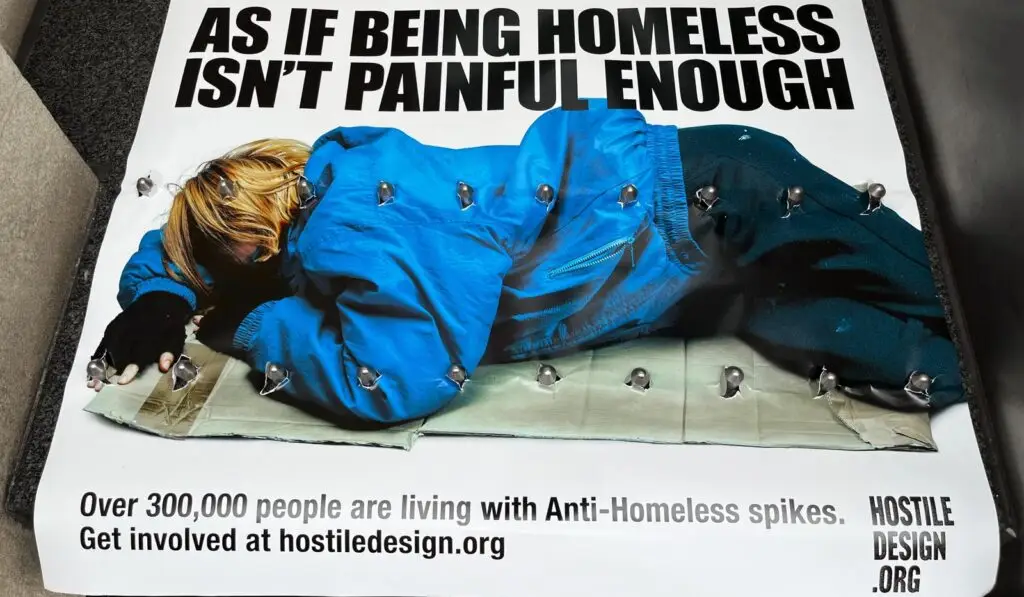Hostile architecture is increasingly present in towns and cities across the United Kingdom. This form of design deliberately makes public spaces uncomfortable for homeless individuals.
However, a new campaign aims to spotlight this troubling trend and raise public awareness. Stuart Semple and TBWAMCR, in collaboration with HostileDesign.org, have launched a series of impactful ambient posters placed at sites with anti-homeless spikes.
The Rise of Hostile Architecture
Hostile architecture is on the rise in the UK. It targets homeless individuals. It makes them feel unwelcome in public spaces.
These designs include spikes built into doorways and paved areas. They are intended to prevent homeless people from sleeping in those spots.
These measures are cruel. They show an inhumanity that is often commissioned by local councils.
Campaign Launch
TBWAMCR and Stuart Semple have started a campaign against hostile architecture.
The campaign uses striking ambient posters. Each poster is placed at a site of anti-homeless spikes.
These posters highlight the cruelty involved in hostile design. Real spikes pierce the images of sleeping people on the posters.
This visual representation makes a strong statement. It aims to raise public awareness and support for the campaign.
Social Media Influence
Photos of these posters are now on social media. The aim is to spread the message of the campaign further.
The social media campaign is designed to reach a wide audience. It encourages people to support the HostileDesign.org campaign.
By sharing these images, the public can help raise awareness of hostile architecture.
Statements from Campaign Leaders
Gary Fawcett, the executive creative director of TBWAMCR, was shocked. He said, ‘Life is hard enough for people forced to live on the streets.’
He added that the discovery of such cruel designs was unsettling. Fawcett felt compelled to educate people on this harsh reality.
Stuart Semple praised the campaign’s support. He believes hostile design is often insidious and hard to notice.
Semple emphasised the importance of raising awareness. He wants people to recognise and challenge hostile elements in public spaces.
He stated, ‘Design shouldn’t be perverted to harm the vulnerable.’ Semple advocates for inclusive and supportive city planning.
Importance of Awareness
Raising awareness is crucial to combat hostile architecture. The public must recognise these harsh designs.
Awareness can lead to cultural shifts. It can pressure city planners and designers to adopt more inclusive measures.
Campaigns like this can educate and inspire people. They can foster a more compassionate approach to urban design.
In the long run, an informed public can drive positive change. They can push for designs that nurture and support all community members.
Educational Efforts
The campaign also aims to educate the public. Knowledge about hostile architecture can empower people to take action.
Educational efforts can include workshops and talks. They can help people understand the impact of these designs.
Informed citizens are better equipped to advocate for change. They can challenge local councils and demand humane urban designs.
Public Engagement
Public engagement is a key goal of the campaign.
By involving the community, the campaign hopes to create a collective voice. This voice can call for an end to hostile architecture.
Community involvement can take many forms. This includes attending events, sharing information, and advocating for change.
When people come together, they can make a significant impact. They can influence policy and promote more inclusive urban designs.
The Role of City Planners
City planners play a crucial role in urban design.
They have the power to create inclusive and supportive environments. Their decisions can impact the well-being of all community members.
Campaigns like this highlight the need for ethical city planning. They urge planners to consider the impact of their designs on vulnerable populations.
Future Goals
The campaign has long-term goals.
It aims to change the way public spaces are designed. The objective is to create environments that welcome everyone, including the homeless.
Future efforts will focus on continuing to raise awareness. They will also push for policy changes and humane urban design practices.
The campaign led by TBWAMCR and Stuart Semple brings to light the hidden cruelties of hostile architecture. Its success hinges on public awareness and engagement.
By unifying communities and encouraging active participation, there’s hope for more compassionate urban designs. The goal is a future where no one is made to feel unwelcome in public spaces. The significance of this initiative extends beyond aesthetics, aiming for a humane and inclusive urban environment.

